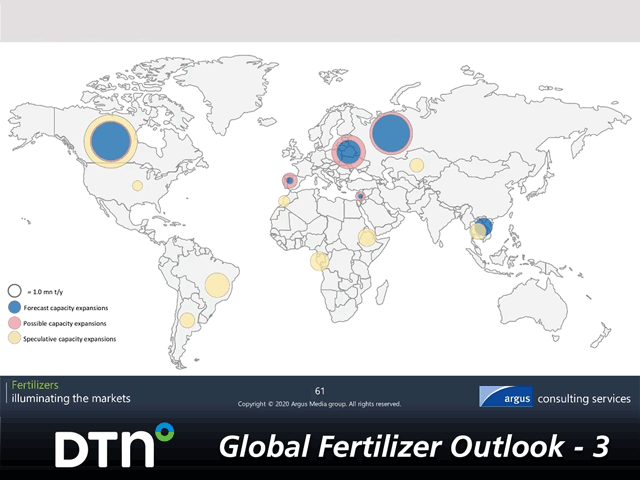Global Fertilizer Outlook - 3
Potash Market Could Be Oversupplied
OMAHA (DTN) -- The global potash (K) market saw limited supply capacity additions in 2020, but new capacity in 2021 could push the market into an unbalanced situation. How the market faces this and several other challenges in the short term will determine the nutrient's outlook, according to a fertilizer analyst.
Presentations were made on the short-term market outlook at the 2020 T3 Virtual Fertilizer Conference -- Trends, Technology and Transportation, put on by The Fertilizer Institute (TFI). This new conference replaced TFI's Fertilizer Outlook and Technology Conference as well as the North America Fertilizer Transportation Conference.
MORE K SUPPLY
Hasan Tarique, fertilizers senior consultant for Argus Media, presented the K short-term outlook. The outlook for the K market appears to be slightly unbalanced with potentially more supply additions than demand growth in the short term, he said.
Demand for global K fertilizer in 2020 is expected to be at about 66 million metric tons (mmt) for consumption, while this could rise to 68 mmt in 2021. However, the capacity additions could push the market into a surplus state next year, he said.
With this new supply coming into the market, Tarique said producer discipline will be required to balance the market in the short term. Some producers may have to delay their ramp-up of production to assure some sort of market balance, he said.
Regardless, major capacity additions are on the way in the near term. The usual suspects of Russia, Belarus and Canada will lead the way with expansion, he noted.
Tarique said about 23 mmt of additional K capacity could be added in the next decade with some major projects set to occur in both Russia and Belarus. Of this 23 mmt, only about 7 mmt would be what he would consider "firm" possible additions.
There also could be some capacity additions coming from Canada further down the line, he said.
"There are several options that Nutrien has in terms of brownfield capacity expansion that we look at," Tarique said.
P[L1] D[0x0] M[300x250] OOP[F] ADUNIT[] T[]
COVID TO LIMIT EXPANSION?
Capacity curtailments have provided some support to price for K producers in 2020, he said. The market saw some disruptions from the beginning of the COVID-19 pandemic, which caused many producers to delay supply additions into next year.
Over the next four years, these expansion projects should happen, and this additional supply should come onto the market, according to Tarique.
Despite these potential supply additions, there are issues facing the market that could alter the outlook of the market.
A big challenge that could affect the K outlook would be another round of COVID-19 pandemic shutdowns. The recovery remains unclear, and the effects of a second wave have begun to emerge, he said.
Returning to lockdown measures could disrupt trade logistics with K plants at risk of being closed, Tarique said. Some lockdowns are already coming back into play in Europe, he said.
However, the fertilizer industry has been fairly immune to most of the economic issues plaguing other industries the last six to eight months. Plant closures are unlikely as most K producers have improved hygiene measures, he said.
BRAZIL, INDIA BUY K
Tarique said another aspect of the K market that will affect the short-term outlook is what happens in Brazil and India, two major importers of the nutrient.
Brazil is an agricultural giant in the world fertilizer market. The ag output in the country, mainly soybeans, is expected to rise, and this is fundamentally supportive of K demand, he said.
Potash imports into Brazil in the first half of 2020 outpaced imports for the same period in 2019, Tarique said. Imports for January through August were 11% higher year on year.
Brazil has seen a steady increase in K imports over the last decade as total K consumption has also climbed. Brazilian K consumption is about 10 mmt in 2019, and 2020 numbers will be about 0.7% higher year on year, he said.
Tarique said the demand for K imports into Brazil should continue into 2021.
Another bright spot in the world for K demand is India, he said. The country has seen above-average moisture from monsoons, which should increase plantings.
This has caused Indian K demand to increase significantly. Potash sales as part of a government program in India are up 42%, he said.
"We expect overall 2020-2021 fertilizer year K imports to rise to 4.6 mmt, up from the 4 mmt level a year prior," he said.
US-CHINA DISPUTE A FACTOR
Another wild card for the global K market into 2021 could be the continuing U.S.-China trade tensions.
Tarique said the upcoming administration change in the U.S. probably won't affect the status of the issue between the two nations. Both nations should honor the phase-one part of the agreement, and ag imports into China should continue, he said.
High levels of soybean imports into China should be supportive to global fertilizer markets, he said.
Russ Quinn can be reached at russ.quinn@dtn.com
Follow him on Twitter @RussQuinnDTN
(c) Copyright 2020 DTN, LLC. All rights reserved.






